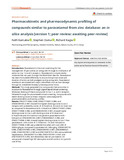Pharmacokinetic and pharmacodynamic profiling of compounds similar to paracetamol from zinc database: an in silico analysis

View/
Date
2023-06-21Author
Kamakia, Faith
Ouma, Stephen
Kagia, Richard
Metadata
Show full item recordAbstract
Introduction: Paracetamol is the most used drug for the
management of pain and as an antipyretic through its mechanism of
action on Cox 1,2 and 3 receptors. Paracetamol is a lipid-soluble
molecule that can pass through the Blood Brain Barrier. Paracetamol
has been formulated differently to ensure the optimal onset and
duration of action as both analgesic and as antipyretic. Paracetamol
overdose is associated with major side effects such as liver damage
through its metabolite N-acetyl-p-benzoquinone Imine.
Methods: This study generated zinc compounds that are similar in
structure to Paracetamol through Ligand-based virtual screening.
Molecular docking of these compounds to Cox 1, 2, and 3 receptors
followed through Structure-based virtual screening. Compounds with
better docking scores to these receptors were analyzed for
pharmacokinetics and toxicity profiles.
Results: ZINC01714506; 0.986; ZINC01714507; 0.986; and
ZINC00394165; 0.987 showed the highest docking scores to cox 3
receptor with probability scores of -6.7kcal/mol, -6.4 and -6.2 kcal/ mol
as compared to Paracetamol with -5.3kcal/mol. ZINC01714507; 0.986;
ZINC01714506; 0.986; and ZINC00394165; 0.987; showed higher
docking scores to Cox 2 with docking scores of -8.3kcal.mol, -
8.1kcal/mole and -8.0 kcal/mol compared to paracetamol with -
6.6kcal/mol. ZINC00394165; 0.987; ZINC00406627; 0.980; and
ZINC01714506; 0.986; showed highest docking scores to Cox-1 than
paracetamol with scores of -7.7kcal/mol, -7.6 and-7.6kcal/mol.
ZINC01714506; 0.986 was predicted the safest with oral LD50 of
2000mg/kg as compared to paracetamol’s 338mg/kg. ZINC00294715;
0.980, ZINC01747085; 0.985, ZINC00394165; 0.987, ZINC00406627;
0.980, ZINC01557001; 0.987 and ZINC19281575; 0.992 were predicted
hepatoactive. ZINC00294715; 0.980; ZINC01557001; 0.987; and
ZINC19281575; 0.992; lack Blood Brain Barrier permeation. All
compounds showed high GIT absorption and all conform to Lipinski’s
rule of five. Conclusion: ZINC01557001; 0.987; ZINC01714506; 0.986;
ZINC34120167; 0.994; ZINC00394165; 0.987, ZINC01714507; 0.986;
and ZINC01747085; 0.985; are promising in drug discovery for new
analgesic and antipyretic drugs, based on better docking scores and
better oral LD50
